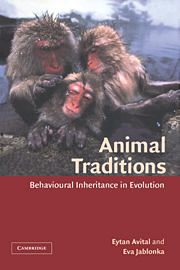Book contents
- Frontmatter
- Contents
- Preface
- Acknowledgements
- 1 New rules for old games
- 2 What is pulling the strings of behaviour?
- 3 Learning and the behavioural inheritance system
- 4 Parental care – the highroad to family traditions
- 5 Achieving harmony between mates — the learning route
- 6 Parents and offspring – too much conflict?
- 7 Alloparental care – an additional channel of information transfer
- 8 The origins and persistence of group legacies
- 9 Darwin meets Lamarck – the co-evolution of genes and learning
- 10 The free phenotype
- References
- Index of species
- Index of subjects
4 - Parental care – the highroad to family traditions
Published online by Cambridge University Press: 28 October 2009
- Frontmatter
- Contents
- Preface
- Acknowledgements
- 1 New rules for old games
- 2 What is pulling the strings of behaviour?
- 3 Learning and the behavioural inheritance system
- 4 Parental care – the highroad to family traditions
- 5 Achieving harmony between mates — the learning route
- 6 Parents and offspring – too much conflict?
- 7 Alloparental care – an additional channel of information transfer
- 8 The origins and persistence of group legacies
- 9 Darwin meets Lamarck – the co-evolution of genes and learning
- 10 The free phenotype
- References
- Index of species
- Index of subjects
Summary
Parental care in birds and mammals is so familiar to all of us that it seems unlikely that it can hold any fresh surprises or offer any new insights. However, there are important aspects of parental care that are commonly overlooked when its role in evolution is discussed. Parental care is one of the major routes through which information is transferred across generations. It is largely through the effects of parental care that animal traditions become established. The information transmitted through parental care relates to all the aspects of life; some is used everyday, some only rarely. Information is transmitted through several different but usually interacting channels, and is essential for the survival and reproduction of the offspring. A look at some typical parental behaviour, that of the common domestic mouse, will show the remarkable range and importance of the information that is transmitted from parent to offspring.
Dusk is a good feeding time for village mice. The small, four-month-old, greyishbrown female domestic mouse silently scales the outer wall of the village grocer's warehouse. She enters the warehouse through a small crack in the wall, and quickly slides down to the piles of bags containing pinhead oatmeal and canary seed. This urine-marked route leads safely to the best source of solid food around. It was first introduced to her by her mother, three months ago, and has been used by her ever since, at least twice a day, at dawn and dusk. […]
- Type
- Chapter
- Information
- Animal TraditionsBehavioural Inheritance in Evolution, pp. 105 - 140Publisher: Cambridge University PressPrint publication year: 2000



